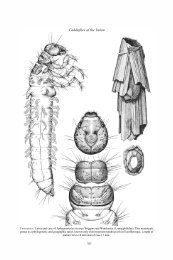Orthopteroids (Orthopteroidea) of the Yukon (V.R. Vickery)
Orthopteroids (Orthopteroidea) of the Yukon (V.R. Vickery)
Orthopteroids (Orthopteroidea) of the Yukon (V.R. Vickery)
Create successful ePaper yourself
Turn your PDF publications into a flip-book with our unique Google optimized e-Paper software.
236 V.R. <strong>Vickery</strong><br />
Xanthippus buckelli is considered by Otte (1984) to be merely an ecophene population <strong>of</strong> a<br />
widely variable species, X. corallipes Haldeman.<br />
The genus Arphia probably survived south <strong>of</strong> <strong>the</strong> glacial incursions and later moved<br />
northward, with one species, A. conspersa (8), reaching <strong>the</strong> lower half <strong>of</strong> <strong>the</strong> <strong>Yukon</strong> and<br />
adjacent Alaska and Northwest Territories. This species has not become established in<br />
eastern Canada. A. conspersa is alate and might have been expected to have spread eastward<br />
as well as northward or southward. Its preference for arid conditions may have been <strong>the</strong><br />
limiting factor. It is tolerant <strong>of</strong> cold which may suggest Beringian survival but, if so, it must<br />
also have survived south <strong>of</strong> <strong>the</strong> glacial ice.<br />
Melanoplinae. The Subfamily Melanoplinae is represented in <strong>the</strong> <strong>Yukon</strong> by 5 species <strong>of</strong><br />
Melanoplus (Melanoplini) and one species <strong>of</strong> Bohemanella (Podismini).<br />
The Tribe Melanoplini has evolved in a Nearctic centre <strong>of</strong> radiation in <strong>the</strong> southwest<br />
area <strong>of</strong> <strong>the</strong> continent (Rehn 1958), probably from ancestors that had dispersed widely over<br />
Europe and North America before <strong>the</strong>se continents separated. The same ancestors probably<br />
gave rise in <strong>the</strong> Old World to <strong>the</strong> Subfamily Catantopinae. The genus Melanoplus is<br />
represented in <strong>the</strong> <strong>Yukon</strong> by 5 species, M. borealis, M. sanguinipes, M. bruneri, M. kennicottii,<br />
and M. fasciatus (1–5). The distribution and cold hardiness <strong>of</strong> <strong>the</strong>se species indicate<br />
that <strong>the</strong>y may have survived glaciation in a Beringian refugium and moved southward when<br />
<strong>the</strong> ice receded but <strong>the</strong>y also could have survived south <strong>of</strong> <strong>the</strong> ice and later extended <strong>the</strong>ir<br />
ranges northward to occupy <strong>the</strong> territory where <strong>the</strong>y now occur. The latter 3 species are now<br />
found mainly in nor<strong>the</strong>rn regions but <strong>the</strong> first 2 are much more widespread. Most o<strong>the</strong>r<br />
species <strong>of</strong> Melanoplus are less tolerant <strong>of</strong> cold and undoubtedly survived glaciation south<br />
<strong>of</strong> <strong>the</strong> ice sheet.<br />
Bohemanella frigida (6), <strong>the</strong> sole member <strong>of</strong> <strong>the</strong> Podismini found in <strong>the</strong> <strong>Yukon</strong>, has<br />
more recently occupied nor<strong>the</strong>rn North America and is discussed under Palaearctic immigrants.<br />
There are several subspecies in Asia (Bei-Bienko and Mishchenko 1963). The Asian<br />
subspecies nearest to Alaska is B. frigida kamchatkiae (Sjöstedt). It differs from B. f. frigida<br />
mainly in having smaller eyes and <strong>the</strong> mesosternal interspace is slightly wider. I have not<br />
been able to examine specimens but <strong>the</strong> nor<strong>the</strong>rn Nearctic specimens appear to be closer to<br />
B.f. frigida.<br />
Migration from <strong>the</strong> Palaearctic Region. Many orthopteroid taxa apparently evolved in <strong>the</strong><br />
Asian ‘Angaran’ centre in <strong>the</strong> Palaearctic region (Rehn 1954, 1958). Migration <strong>of</strong> taxa to<br />
<strong>the</strong> Nearctic must have occurred several times, <strong>the</strong>se taxa subsequently extending <strong>the</strong>ir range<br />
and occupying areas <strong>of</strong> <strong>the</strong> Nearctic region. Knowledge <strong>of</strong> <strong>the</strong> taxa involved and <strong>the</strong> time(s)<br />
<strong>of</strong> penetration to <strong>the</strong> Nearctic are not definitely known, due to lack <strong>of</strong> fossil and o<strong>the</strong>r<br />
surviving records. <strong>Vickery</strong> (1989) summarized <strong>the</strong> current knowledge <strong>of</strong> orthopteroid fossil<br />
records in Canada. Old World–New World relationships provide good evidence for use <strong>of</strong><br />
a Beringian land bridge and possible survival <strong>of</strong> some taxa in a Beringian refugium.<br />
In general <strong>the</strong> orthopteroids <strong>of</strong> <strong>the</strong> eastern Palaearctic are not well known and it is not<br />
known whe<strong>the</strong>r some <strong>of</strong> <strong>the</strong> relatives <strong>of</strong> <strong>the</strong> Nearctic immigrants have survived <strong>the</strong>re.<br />
Holarctic Genera. The genus Tetrix is truly Holarctic. One species <strong>of</strong> <strong>the</strong>se pygmy grasshoppers,<br />
T. subulata (15), is relatively common in both Palaearctic and Nearctic regions.<br />
Ano<strong>the</strong>r Nearctic species, T. brunnerii (16), is closely related to <strong>the</strong> Palaearctic ‘Clinotettix’<br />
(or Tetrix) ussuriensis Bei-Bienko. It is probable that <strong>the</strong> latter species should be transferred<br />
to Tetrix. In <strong>the</strong> past <strong>the</strong> 2 species were thought to be conspecific by some authors. The third<br />
Nearctic species, T. ornata (17), is not closely related to <strong>the</strong> o<strong>the</strong>r 2 and does not have a
















